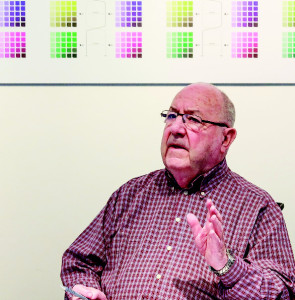Color Drives Business & Influences Buying Descisions
November 17, 2016
LONDON, England — Did you know that color is the key influencer in 85% of all consumer decisions across all product categories?
When you take this fact into consideration it is obvious how important color is in product development. It’s no secret that design teams in many companies find it difficult to explain why they have decided to take a new collection in a certain color direction. The design team’s color decision is often hard to explain to the sales department or upper management.
 Niek De Prest
A universal color language system can work to bridge this gap. What if there was a communication tool to validate color choices where designers, management, R&D, purchasing, and marketing could all speak the same color language? Colors systems like Pantone, NCS, RAL, have been tried and true tools of the trade.
The Color Passport system makes it more understandable and easier to work with color. When 62% to 90% of snap judgments about products can be based on the color alone, it is imperative that businesses do not ignore the power of color, whichever system they chose to utilize.
After 50 years of research, the Color Passport system was born (2015). This system creates measurable color choices that can then be communicated to all types of professionals. Color Passport has launched a unique color system with an 81-year-old civil engineer in textiles and color named Luc Van Renterghem.
Color Passport and its Color Cluster System is the result of decades of research into the influence of color on our brains and how we experience color. The system enables color to be identified according to scientific values. It is based on individual color passports, which can identify the attributes of a color using its unique technical specifications and its more psychological attributes such as style, culture, and type. The system arranges 7200 colors according to these properties and can also work with Pantone, NCS, and RAL in addition to its own color references.
“Color and color emotion are science-based,” says Luc Van Renterghem. “Every color has its own ‘Color Passport’ including all its characteristics, giving a new dimension to the understanding of color, working with color or communicating with color. By looking at the passport of a color, consisting of four numbers and three icons, you immediately know what the color stands for, what its scientific values are, as well as which style and which type of consumer it suits and where the color is relevant geographically. In this way color because measurable and therefore much easier to communicate, not only for creative people but also for those working with color,” he says.
Niek De Prest, owner of Big Fish and trend coach to MoOD Brussels, regularly uses the new system, “Color Passport has created a common language that enables all the people in the organization to discuss the subject of color,” she says. “In my business it is about creating a brand voice based on color. Something every brand should have.” Color is very emotionally driven, and there is also a strong scientific correlation which is harnessed in Color Passport.
As with many things in life you get out what you put in. Color Passport is a valuable tool if you learn how to use it properly. There are workshops and training available to learn the methodology and how to apply it to your specific business. It is a complex, yet learnable system. (I myself took part in a day-long seminar at Color Passport to learn more about color as well as the system and I found it to be valuable, but there is a learning curve just like when learning how to navigate a new word processing software or how to operate the latest smart phone technology. A high level of commitment is needed to get the most value out of the tool.
Something that is appreciated with this system is how any trend color story, like those seen at Heimtextil or MoOD Brussels, can be plugged into the system and adapted to a specific market.
Thierry Lescrauwaet from Color Passport notes, “A personal substantiated Color Passport color profile can be determined for each company or product range, suited to the target audience, the application, the style and a specific geographical market. In this way decisions regarding color are supported scientifically, leading to financial gain. Colors in collections will indeed be more suitable, making the consumer experience the brand as consistent, trustworthy and recognizable.”
Niek De Prest
A universal color language system can work to bridge this gap. What if there was a communication tool to validate color choices where designers, management, R&D, purchasing, and marketing could all speak the same color language? Colors systems like Pantone, NCS, RAL, have been tried and true tools of the trade.
The Color Passport system makes it more understandable and easier to work with color. When 62% to 90% of snap judgments about products can be based on the color alone, it is imperative that businesses do not ignore the power of color, whichever system they chose to utilize.
After 50 years of research, the Color Passport system was born (2015). This system creates measurable color choices that can then be communicated to all types of professionals. Color Passport has launched a unique color system with an 81-year-old civil engineer in textiles and color named Luc Van Renterghem.
Color Passport and its Color Cluster System is the result of decades of research into the influence of color on our brains and how we experience color. The system enables color to be identified according to scientific values. It is based on individual color passports, which can identify the attributes of a color using its unique technical specifications and its more psychological attributes such as style, culture, and type. The system arranges 7200 colors according to these properties and can also work with Pantone, NCS, and RAL in addition to its own color references.
“Color and color emotion are science-based,” says Luc Van Renterghem. “Every color has its own ‘Color Passport’ including all its characteristics, giving a new dimension to the understanding of color, working with color or communicating with color. By looking at the passport of a color, consisting of four numbers and three icons, you immediately know what the color stands for, what its scientific values are, as well as which style and which type of consumer it suits and where the color is relevant geographically. In this way color because measurable and therefore much easier to communicate, not only for creative people but also for those working with color,” he says.
Niek De Prest, owner of Big Fish and trend coach to MoOD Brussels, regularly uses the new system, “Color Passport has created a common language that enables all the people in the organization to discuss the subject of color,” she says. “In my business it is about creating a brand voice based on color. Something every brand should have.” Color is very emotionally driven, and there is also a strong scientific correlation which is harnessed in Color Passport.
As with many things in life you get out what you put in. Color Passport is a valuable tool if you learn how to use it properly. There are workshops and training available to learn the methodology and how to apply it to your specific business. It is a complex, yet learnable system. (I myself took part in a day-long seminar at Color Passport to learn more about color as well as the system and I found it to be valuable, but there is a learning curve just like when learning how to navigate a new word processing software or how to operate the latest smart phone technology. A high level of commitment is needed to get the most value out of the tool.
Something that is appreciated with this system is how any trend color story, like those seen at Heimtextil or MoOD Brussels, can be plugged into the system and adapted to a specific market.
Thierry Lescrauwaet from Color Passport notes, “A personal substantiated Color Passport color profile can be determined for each company or product range, suited to the target audience, the application, the style and a specific geographical market. In this way decisions regarding color are supported scientifically, leading to financial gain. Colors in collections will indeed be more suitable, making the consumer experience the brand as consistent, trustworthy and recognizable.”
 Luc Van Renterghem
Luc Van Renterghem
In a nutshell, how does the system work? A passport is given to each color, which allows the user to pinpoint its own unique identity and interpret 7810 colors. All CP Passports distinguish four numbers for hue and color intensity and three icons that clarify the specific type of color or consumer, the style and the cultural or geographical relevance of its use. All of these colors are reproducible and provided with values in RGB, CMYK, HEX and Lab and are thus manageable with other color systems such as RAL, NCS and Pantone. The exclusive ICC color passport profile ensures a controlled color outcome for reproduction methods such as a CMYK environment.
 Niek De Prest
Niek De Prest Luc Van Renterghem
Luc Van Renterghem In a nutshell, how does the system work? A passport is given to each color, which allows the user to pinpoint its own unique identity and interpret 7810 colors. All CP Passports distinguish four numbers for hue and color intensity and three icons that clarify the specific type of color or consumer, the style and the cultural or geographical relevance of its use. All of these colors are reproducible and provided with values in RGB, CMYK, HEX and Lab and are thus manageable with other color systems such as RAL, NCS and Pantone. The exclusive ICC color passport profile ensures a controlled color outcome for reproduction methods such as a CMYK environment.










